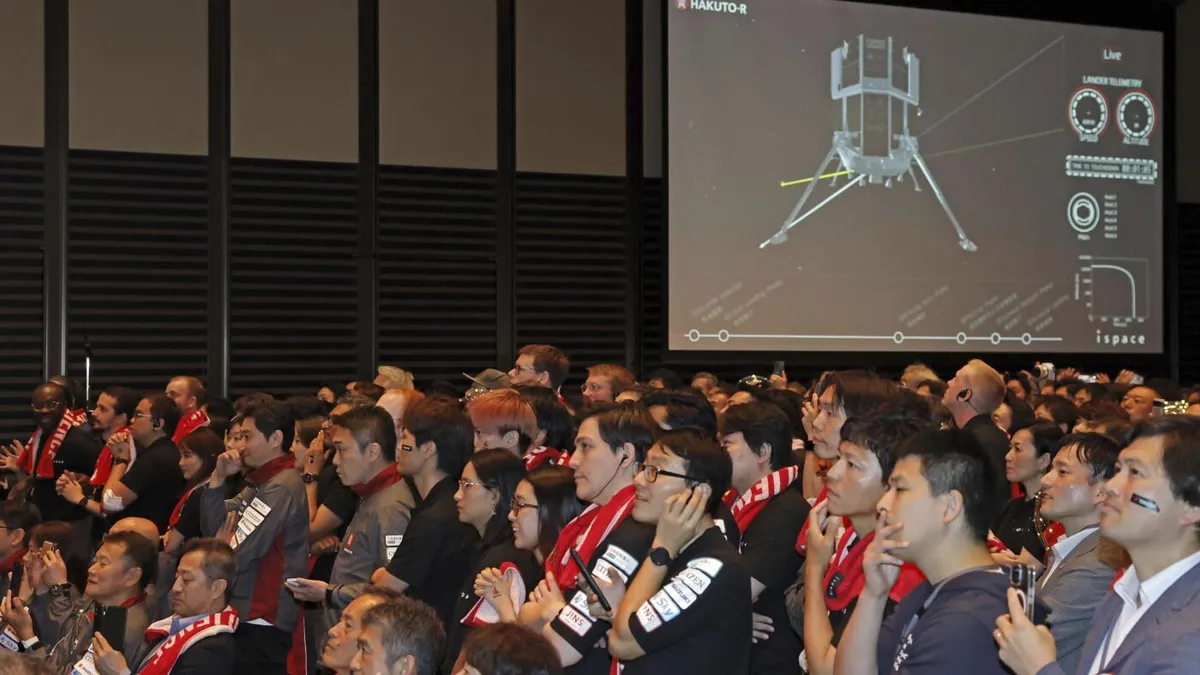
A private lunar lander from Japan, developed by the Tokyo-based company ispace, tragically crashed while attempting to land on the moon on Friday. This incident marks the latest setback in the rapidly evolving commercial race to explore lunar territory. Several hours after communication with the lander was lost, ispace officially declared the mission a failure. Flight controllers worked frantically to re-establish contact, but they were met with silence, ultimately leading them to conclude the mission.
Remarkably, communication ceased less than two minutes before the spacecraft was scheduled to touch down on the lunar surface, where it was set to deploy a mini rover. Up until that critical moment, the descent from lunar orbit appeared to be progressing without issue. In a heartfelt statement, CEO and founder Takeshi Hakamada expressed his apologies to all those who contributed to the mission, which represents the second failed lunar landing attempt for ispace.
This failure follows a similar incident two years prior when ispace's first moonshot ended in a crash landing. That mission’s unfortunate outcome led to the naming of its successor lander, Resilience. The Resilience lander was designed to carry a rover equipped with a shovel to collect lunar soil, along with a whimsical toy-sized red house designed by a Swedish artist for placement on the moon's surface.
Company officials have stated that it is too early to determine whether the same issues affected both missions. Hakamada remarked, "This is the second time that we were not able to land. So we really have to take it very seriously." He reassured reporters that ispace is committed to pursuing additional lunar missions despite these setbacks.
Initial assessments suggest that the lander’s altitude measurement system, which utilizes lasers, did not function correctly. Consequently, the lander descended too rapidly, leading to what is currently assumed to be a hard landing on the lunar surface, according to a written statement from the company.
The moon, once solely the domain of government agencies, has become a target for private companies since 2019, with many of these ventures experiencing more failures than successes. Resilience was launched in January from Florida and had a long, indirect journey to the moon. It entered lunar orbit last month and was carried aboard a SpaceX flight alongside Firefly Aerospace's Blue Ghost, which successfully reached the moon and became the first private entity to accomplish a lunar landing in March.
After Firefly, another U.S. company, Intuitive Machines, also reached the moon shortly after. However, its lander encountered difficulties, crashing in a crater near the moon's south pole and being declared non-operational within hours. In contrast, Resilience was targeting a less hazardous area on the moon, specifically a flat region known as Mare Frigoris, or the Sea of Cold, which is characterized by craters and ancient lava flows.
The mission plans included the 7.5-foot Resilience transmitting images back to Earth shortly after landing and deploying the rover, named Tenacious, onto the lunar surface this weekend. Constructed from carbon fiber-reinforced plastic, Tenacious featured a high-definition camera for scouting and a shovel designed to collect lunar samples for NASA. Weighing only 11 pounds, the rover was planned to operate in close proximity to the lander, moving at a leisurely pace of less than one inch per second, with the capability to travel up to two-thirds of a mile away.
In addition to its scientific and technical objectives, the rover carried a tiny, Swedish-style red cottage, dubbed the Moonhouse by its creator, Mikael Genberg, intended for placement on the lunar surface. Just minutes before the attempted landing, Hakamada reassured stakeholders that ispace had drawn lessons from its previous failure, stating that engineers had done everything possible to ensure success this time.
Despite the recent setback, Hakamada views this latest moonshot as just a steppingstone toward greater ambitions, including plans to launch a larger lander by 2027, with NASA’s involvement. Jeremy Fix, chief engineer for ispace's U.S. subsidiary, highlighted the financial constraints faced by the company, emphasizing that repeated failures are not sustainable. While the exact cost of the current mission has not been disclosed, it is reportedly lower than that of the first mission, which exceeded $100 million.
As the commercial lunar exploration market heats up, other U.S. companies, including Blue Origin founded by Jeff Bezos and Astrobotic Technology, are also vying for lunar landings by the end of the year. Astrobotic’s first lunar lander experienced a mishap in 2024 when it missed the moon entirely and crashed back through Earth's atmosphere.
Historically, only five countries have successfully executed robotic lunar landings: Russia, the U.S., China, India, and Japan. Notably, the U.S. remains the only nation to have landed humans on the moon, with 12 NASA astronauts accomplishing this feat between 1969 and 1972. Looking forward, NASA plans to send four astronauts around the moon next year, paving the way for the first crewed lunar landing in over fifty years, using SpaceX's Starship for the journey from lunar orbit to the surface. Meanwhile, China has its own plans for sending astronauts to the moon by 2030.